2017

A Story of a House in the Walls
by
HERA-C
Ceren Boğaç, Afet Coşkun, Kağan Günçe, Nevter Zafer Cömert, Yonca Hürol
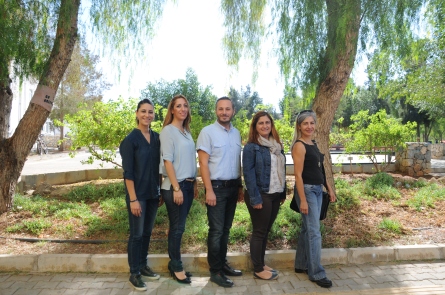
EMU Faculty of Architecture, Housing, Education, Counselling and Research Center, addresses multi-dimensional housing cases. At the national level of existing knowledge the center intends to transmit on the subject of housing in both public sector and the private sector as well as provision of common use by both sectors in development co-operation and application area. In this context, the aims of the center are to provide realization of unity between research, design, implementation and consultation. EMU Faculty of Architecture, Housing, Education, Counselling and Research Centre’s field are physical, socio-economic, technological, cultural, and legal as well as covers all scientific dimensions of housing cases.
Within the scope of the workshop, it is aimed to produce ‘slow movies’, where fragments of life are related to the houses, which will be told with fiction stories. In this context, it is expected that in Walled city of Famagusta, the workshop participant will develop their own stories about the selected houses and will display them as 2 minute slow-motion movies by using different media techniques. Within the framework of the workshop, the participants will learn to observe daily encounters of the city life and learn to share their fictional housing stories through different medias.
At the first day of the workshop, workshop executers gave a crash course about how to develop a storyboard and basics of stop motion animation techniques to the participants. Following, various ‘house stories’ from fairy tales to books, personal narratives to fictions were discussed with the participants. The participants made a trip to the walled-city of Famagusta to trace for inspiration and develop their early scenarios related to movies. Second day, the proposed story boards of the movies were discussed and the production began. At the third day of the workshop participants showed the draft edits of the movies and finalized them after critiques. At the end of the third day, two short stop motion animations movies screened on a particularly designed place.


2016
International Association of People Environment Studies (IAPS) Culture and Space Network
&
Eastern Mediterranean University, Faculty of Architecture Housing Education, Research and Advisory Centre (HERA-C) Partnership
IAPS Culture and Space Network Symposium + Workshop 5 Borders: Con ict and/or Potential Experiencing NICOSIA
28 – 31 October 2015, Nicosia (Bedestan)
As the capital of Cyprus, Nicosia as a politically as well as a physically divided city has been selected as a venue to create a common understanding on con icted urban settlements.
The Main Theme focuses on four topics experiencing the divided city of Nicosia:
• Division / divided city
(Any relevant subject related to the physicality of having a political border, a bu er zone, etc).
• Borders and territories
(Issues focusing to the abstract and/or concrete borders, alienation, segregation in urban environment).
• Public space, identity and memory
(Everyday use of public space, perception and attachment). • Heritage, branding and the image of the city
(Topics related to the e ects of capitalism on cities, post neoliberal urbanism, heritage, city management and tourism).
SPEECHES
RETROSPECTIVE READING OF NICOSIA’S CITY IDENTITY
Assoc. Prof. Dr. Mukaddes Fasli
This presentation expresses unique city identity of Nicosia in Cyprus. It begins with a brief review of the concepts of identity and city identity. Thereafter, it introduces the indicators and the determinants of a city’s identity.
There are two main indicators of a city’s identity: environmental and social. Environmental identity has two main determinants; natural and man-made environmental characteristics while social identity has three main determinants; socio-political, socio-cultural, and socio-economic characteristics. This presentation aims to put forwards retrospective reading of Nicosia’s city identity from Lusignan Period (1192-1489) till today (2015).
Nicosia is the capital city of Cyprus and the last divided capital in Europe. Cyprus is an island in the eastern part of Mediterranean Sea. Due to its strategic location, it has been ruled by many nations throughout history: From 1192 to 1489 the Lusignans, 1489 to 1571 the Venetians, 1571 to 1878 the Ottomans, and after 1878 until 1960 the British governed the island. All the societies who had lived on the island were influenced the city identity of Nicosia.
NICOSIA AS A CONFLICTED SETTING
Prof. Dr. Naciye Doratlı
The amalgam of cultures that shaped Cyprus’ unique identity has also contributed to its turbulent history, as reflected in its capital city. Nicosia, the capital city of the strategically located island in the Mediterranean Sea, is a unique settlement as being the only divided city, the divided capital in Europe, which is a setting of conflict and division over the last half century. It is a city, which cannot be described without referring to the tangible and intangible walls, which has been boldly coded into its entity and became an indispensable component of its identity.
In order to understand the conflicted setting of Nicosia, one should have an insight, firstly, into formation, meaning and process of change of the walls between the two communities; and secondly the process of partition/ division, along which the buffer-zone has been carved into the fabric of the city. Additionally, interpretation of the community identity of the Turkish Cypriots and Greek Cypriots along the partitioning/division process will contribute to the perception of the conflicted setting of the city.
Following a brief introduction of the concept of wall as well as the classification of the walls according to their function and the process of division, with this presentation it will be attempted to interpret the conflicted setting, which is expected to establish a ground for determining the potential and generating creative ideas and proposals.
Keywords: Nicosia, walls, partition, division, buffer-zone.
Innovative Approaches to Presentation Techniques for Participatory Projects in (Post) Conflict Areas
Esra Can Akbil and Münevver Özgür Özersay
It is an inevitable fact that all urban and architectural design projects need to communicate with their multilayered audiences as authentically and conveniently as possible. Parallel to this, it is also very clear that there is a greater acceptance of the potential role of architecture and urbanism in conflicted/ post conflict areas as moderators of positive change; mainly by providing participatory design tools that can contribute to sustainable peace through spatial design and influencing decision making processes. When looked from this perspective, two major questions arise: How can design serve as a process that makes room for public participation? How can research and design data be turned into design tools, which are accessible to all? This presentation tries to give answers to these questions by looking at several innovative and inspirational examples dealing with spatial issues of (post) conflict areas in Euro-Mediterranean region.
WORKSHOPS
Rethinking the Border (Urban ID / Nicosia)
Gjergji Islami
The workshop will focus on the interrelation between the user and the public space as a tool to understand the complex nature of the built environment. By exploring the ambience of Nicosia and its contrasting realities, the debate will follow from the tangible dimension to the intangible one; from material to immateriality; from concrete to abstract; from activity to culture; from context to content. The output will be an attempt to materialize the Urban ID of the common ground where the space dialogues through its syntax with the social activity. A poster and a short movie sequence will be the manifesto for the workshop.
A CITY INTERLACED?
Demet Mutman, Esra Akbalık, Hale Sinirlioğlu, Hülya Turgut
Within the globalized world, cities are facing forms of abstract and concrete fragments through their social, economic and spatial structures. Borders of political struggles are in an interactive change through new forms of economic and social dissolution, changing practices of daily lives, pushing effects of the global economic conditions and of today’s social culture. New forms of collaborations, dialogue and mutual economies create many alternative ways of new urbanities and social structures at many places including conflicted environments with few effects on the political confrontation.
In this context this workshop aims focusing on the sliding zones between the local and the global worlds of the city of Nicosia. It’s politically divided reality in this manner aims to overlay a new form of focus where preferences, traditions, habits of the society (with no relation to their political ID’s) and effects of capitalism on current socio-spatial practices, overlay different forms of constitutions. Different paths of the concept of consumption will be analyzed on one hand through various economic preferences, daily routines and lives or on the other hand among the consumed spatial environments, political realities, urban market economies.
With mental maps, spatial stories, socio-political acts, interviews and different forms of documentaries as the tools of this workshop, the final aim is to develop a revelation of the interlaced city of Nicosia and/or interlacing contour through uses of everyday lives, practices and preferences.
Dynamic Urban Design, Approach towards a New Nicosia (Infrastructure & Mobility in the Divided City)
Prof. Dr. Frank Gaffikin & Dr. Ken Sterrett
We would conduct a workshop on the above theme, addressing the way that public infrastructure in Nicosia, such as roads, pavement quality; pedestrian access; public transport, and such like, act inadvertently to impede permeability and mobility across the city, thereby accentuating rather than ameliorating the fractured nature of a bisected city.
The workshop would identify: (1) the specific ways that urban planning and design can contribute barriers to an open and bonded urban environment; (2)the impact such commissions and omissions can exert on further rupture of the urban fabric; and (3) an alternative form of public intervention, based on the spatial planning model, that would amplify the public realm and connectivity.
Conception of Urban Narratives- Through Urban Encounters upon «Lokmaci Gate»
Nil Paşaoğluları Şahin, Resmiye Alpar Atun
Divided cities comprise territorial and non-territorial divisions; layers of conflicted meanings, as well as urban forms and spatial practices. To conceptualize divides in cities this workshop tries to discuss the conception of “Border/Gate” upon practice-based experiences enabling urban narratives. The methodology will base on interviews, exploring everyday practices and perceptions upon encountering Border/Gate/Boundary/…
The urban space may provide an opportunity to elaborate urban practices from micro-level analysis that may function as a site for fusion of theory and practice. The ambition of this workshop is thus to map differentiated urban practices, upon encountered experience of border/gate. In this study, it will be focused on multiple responses of different user profiles / people (inhabitants/visitors/…) to the role of ‘border’ as an object (separate entity), as a transition element (between two sides), as a barrier (blocking the passage).
Morphology of Territorial Cycles: Nicosia’s Buffer Zone, From Dividing Line to Accentuation Axis
Alessandro Camiz
The urban settlement of Nicosia (former Ledra) started in Bronze Age on the two sides of the river Pedieos (Kanlı Dere), along the intersection of the valley route following that river, and the cross-valley route connecting the
Pentadaktylos ridge and the Troodos ridge, and developed as an exchange point between the two sides of the river. Only in Byzantine times, hosting a bishopal seat since the X century, the city became the capital of the island and was surrounded by a wall. During the Venetian rule, in 1567, new walls, designed by the Venetian engineers Giulio Savorgnano and Franscesco Barbaro, replaced the medieval ones. The construction of the new walls included the infilling of the river within the city so to move its waters into a new moat surrounding the city. A new urban tissue gradually replaced the riverbed, flanked by the sinuous streets that followed its former course inside the ancient city. This approach to urban planning is typical of the Venetian rule: the Venetians accomplished a similar infilling in Ravenna in the XV cent. At Nicosia the three existing bridges, where crossroads connected the two sides of the city, maintained their polar role after the river infilling. The Venetians might have not completed their transformation, hence the Ottoman siege of the city in 1570, but in continuity with the first
Venetian urban transformation the general restructuration of the city in Ottoman times, used the areas above the infilled river. Since then, this area becomes the city centre. It is not a coincidence, according to Saverio Muratori’s theory of territorial cycles, that after the 1974 civil war, the UN divided the city in two parts following exactly the same track of the former river Pedeios. According to Muratori, urban settlements, as organisms, follow cycles that are connected to a larger territorial organism. The transition from a river (border/dividing axis) to central urban tissue (centre/accentration axis) and its further transformation into the buffer zone (again a border/dividing axis) continues the very same cycle. From these simple historical and morphological considerations, it is possible to infer the future of the buffer zone. Following the new phase of bilateral talks recently started in Cyprus, at some point, we cannot predict exactly when, this area will again become the city center, an accentration axis. In this future phase, the value of the land will rise exponentially therein, and the speculative appetites will try to build as much as possible. We have to be very careful so to facilitate this process of reunification, safeguarding the urban tissues and the historical buildings of the buffer zone: we should restore and reactivate the urban tissues to keep the memory of the recent past, but not delete them to leave place for a new downtown with skyscrapers.
It is therefore a confirmation of Saverio Muratori’s theory that the existing Ledra street checkpoint, connecting the two sides of the walled city, is on the site of the old bridge. So new “bridges” should be designed to connect the two sides, as public open spaces, squares or parks, preserving as much as possible the existing urban tissues, the roads’ network, and the historical buildings.
Muratori S. (1967). Civiltà e territorio, Roma, Centro Studi di Storia Urbanistica,
Cataldi, G., Maffei L., Vaccaro P. (2002). ‘Saverio Muratori and the Italian school of planning typology’, Urban Morphology, 6, 1, 3-14.
Conzen, M.P. (2013). ‘Substance, method, and meaning in urban morphology’, Urban Morphology, 17, 2, 132-134.
Strappa, G. (2013). ‘Territorial organism and urban knotting. Design methods for minor centers of Lazio’, FA magazine, 23, July-August, 19-23.
Camiz, A. (2014). Urban Morphology and Architectural Design of City Edges and Vertical Connections in Historical
Contexts, in New Urban Configurations, Cavallo, R., Komossa, S., Marzot, N., Berghauser Pont, M., Kuijper, J. (eds.), Delft University Press/IOSPress, Amsterdam, 227 – 234
Spaces of Hope/ Spaces of Despair: The Walled City of Nicosia
Prof.Dr Tovi fenster
The aim of this workshop is to identify and analyze everyday life in buffer zones in Nicosia’s urban spaces. In particular, we will use de Certeau’s definitions of tactics and strategies to identify and analyze the built and social environment in specific zones in Nicosia as reflecting ‘strategies’. At the same time, we will initiate ‘cultural and social readings’ of these urban spaces aiming to identify how women and men use, react, perceive such urban spaces and whether we can observe ‘patterns’ of urban behavior or ‘tactics’. For example, if people don’t use or over use certain areas in buffer zones or if people stay in certain parts or not. And if possible, what do people feel towards these areas. The end result of this workshop is to draw the visible and mental borders in Nicosia’s public spaces and to conclude whether they reflect conflict or potential.
The methods used are mainly participant observations and short interviews with city users.
»program
of the workshop
…
2015
COMFORTABLE LIVING WORKSHOP (21.05. – 22.05.2015)
prepared by Assist.Prof. Dr. Harun Sevinç,
Part-time Instructor Kemal Kasapoğlu
The “HERA-C Comfortable Living Workshop” was based on three workshop activities:
- Lectures about “comfort and efficiency”, its efficiently use in architecture and information about thermal comfort and energy efficiency (1st day)
- Short-Film Preparation: A short-film about the students’ existing heating and cooling systems in their dormitories and residential and the problems in cold season (winter) and in hot season (summer).
- Film Presentation at the end of the day (2nd day).
At the same time a poster exhibition about ecological buildings was offered to the participants to achieve awareness about ecological issues in architecture.
2 students from 2nd, 3rd and 4th Academic Year of undergraduate program besides 6 students related to the M.Sc. and Ph.D. program participated in this realistic short film production.
Used materials and tools:
Smartphones and laptops
Exhibition boards in the atria
…
2014
Creating Design Proposals for the Echo Village of Baglikoy Nazife Ozay (HERA-C), Mukaddes Fasli (KENT-AG)
21-23 Mayıs 2014 tarihleri arasında, Doğu Akdeniz Üniversitesi, Mimarlık Fakültesi, 4. Tasarım Haftası etkinlikleri çerçevesinde KENT-AG (URDC) araştırma merkezi yönetim kurulu üyesi Doç. Dr. Mukaddes Faslı, KEDA-M (HERA-C) araştırma merkezi yönetim kurulu üyesi Yrd. Doç. Dr. Nazife Özay ve Mimarlık Bölümü araştırma görevlisi Rokhsaneh Rahbarianyazd tarafından “Bağlıköy Eko-turizmi için Tasarım Önerileri” başlıklı atölye çalışması düzenlenmiştir. 25 Mimarlık Fakültesi öğrencisi ile yürütülen çalışmanın ilk gününde eko-köy, eko-turizm ve Bağlıköy hakkında yapılan genel açıklamaların ardından, Bağlıköy’e teknik gezi düzenlenmiştir. Bu gezi kapsamında yerinde gözlem, yerel halk ile röportaj ve fiziksel analiz çalışmaları yapılmıştır. İkinci günde, beşer kişilik gruplar halinde çalışan öğrencilerin sundukları tasarım önerileri üzerinde tartışarak, eko-turizmin geliştirilebilmesi için görüşler üretilmiştir. Üçüncü günde ise, her öğrenci grubu yaptığı gözlemler doğrultunda hazırladığı eskiz çalışmaları ve Bağlıköy eko-turizmi için sunduğu tasarım önerilerini hazırladıkları iki ayrı posterle sunmuşlardır. Yapılan çalışmalar 4. Tasarım Haftası etkinlikleri kapsamında sergilenmiştir.
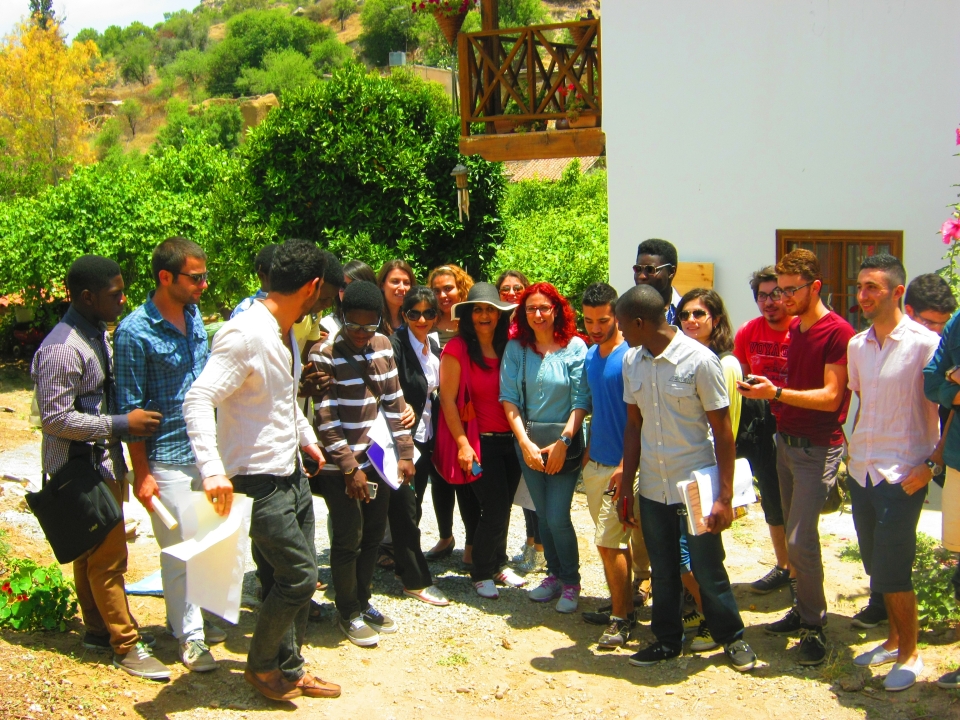
ECO-HOUSE DESIGN WORKSHOP (21.05. – 23.05.2014)
Assist.Prof. Dr. Harun Sevinç & Part-time Instructor Phd.Cand. Ahadollah Azami
The “HERA-C Eco-Design Workshop” was based on three workshop activities:
- Lectures about “passive and active solar energy gain”, its efficiently use in architecture and information about ecological building materials exemplified by successful case studies (1st day)
- Studio work: Planning and design of “a detached single-family house as eco-house” in a selected campus site close to Koop Bank as studio work by a given space program (2nd day).
- Exhibition of the “eco-house projects” (3rd day).
At the same time, a poster exhibition about ecological buildings and non-ecological buildings were offered to the participants to achieve awareness about ecological issues in architecture.
10 students from 2nd, 3rd and 4th Academic Year of undergraduate program besides 6 students related to the M.Sc. and Ph.D. program participated in this realistic designing of ecological house. EMU students from other departments for instance Civil Engineering preferred the workshop to increase their knowledge about realistic ecological architectural design.
Despite the hardness of studio work and time limitation, which was the main disadvantage of the workshop, the expected results in a short time were incredible and successful for the exhibition.
Used materials and tools:
Film material, presentation techniques, sketch paper, 3D-Software programs etc.
Min. 11 desks for studio work,
Exhibition boards in the atria
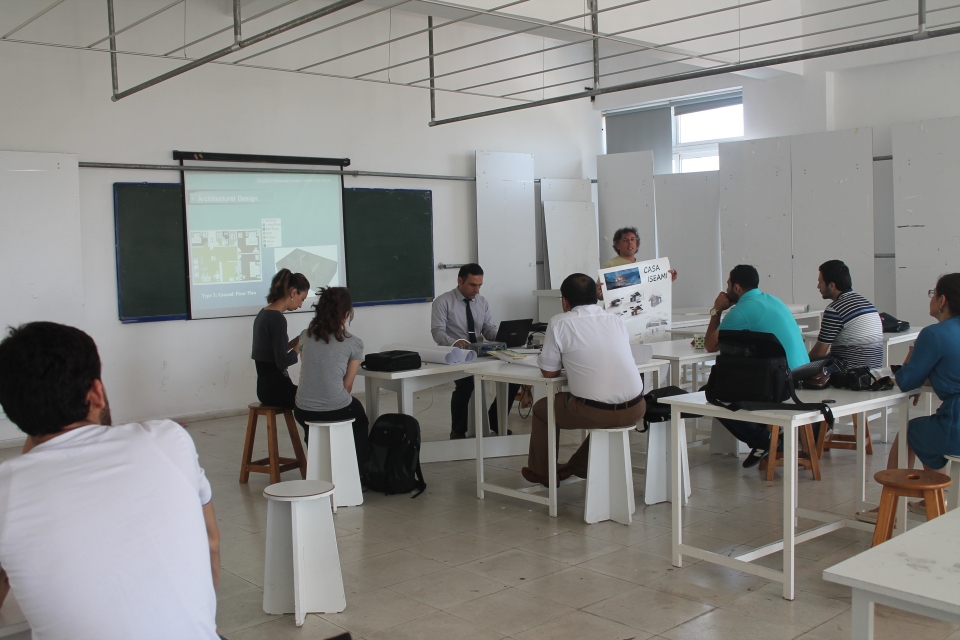
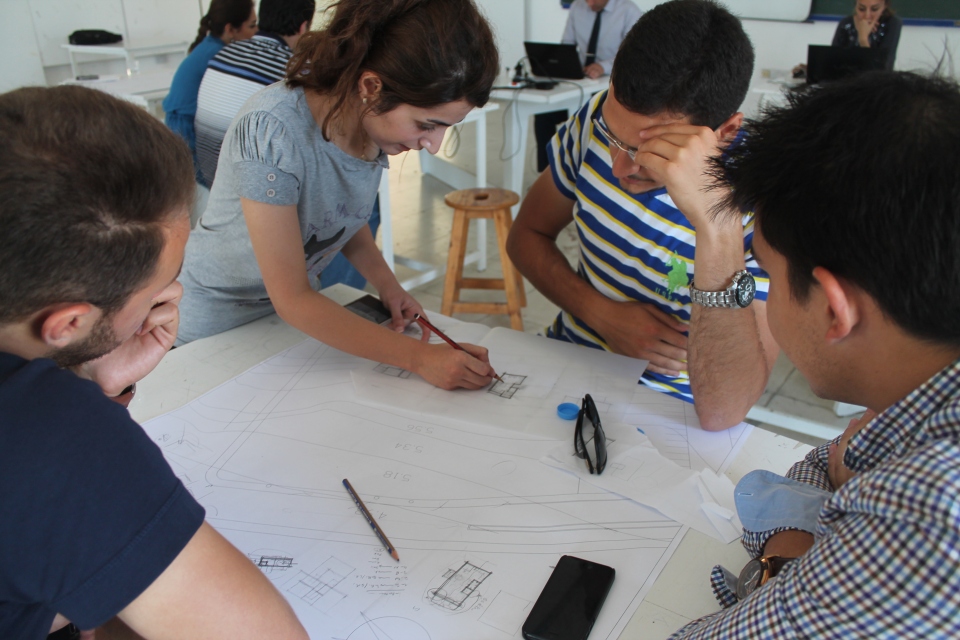
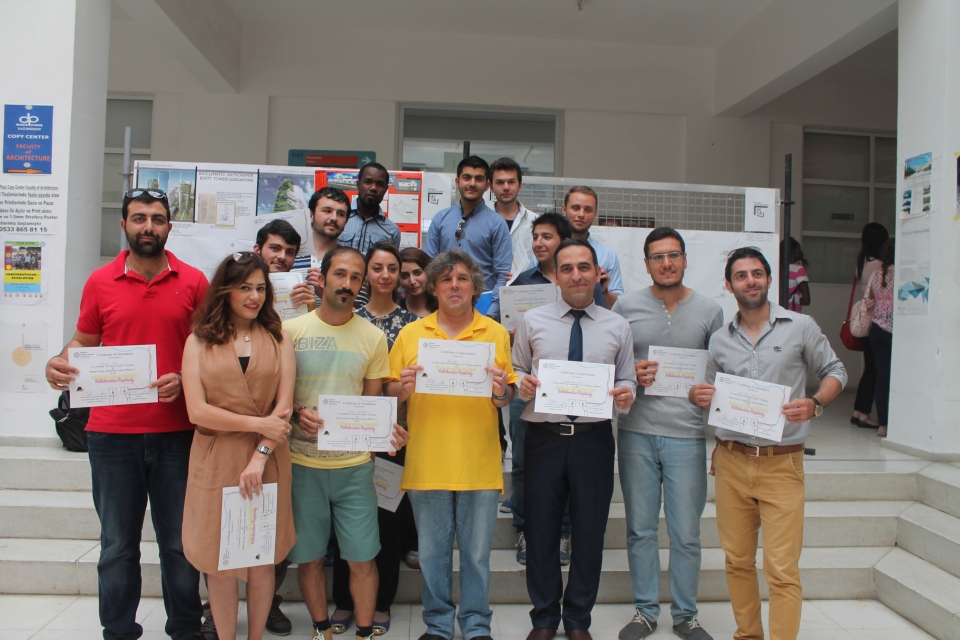
…
2006
U-HERA’s One-Day-Workshop was supervised by Dr. Beril Özmen Mayer under the theme of ‘ Psychology and Grammar of the Streets of Maraş’ , and following the night workshop by Dr. Nesil Baytin under ‘Mediterranean Outdoor Life’ at the same day on 29 july 2006, within the International Summer School: “Revitalization of Street Space in the Mediterranean – Nicosia”, which was a joint effort of ‘Chamber of Cyprus Turkish Architects and ‘CO-ARC’: North Africa Architectural Associations with students and tutors from visiter countries: Egypt, Tunisia, Algeria and Turkey.